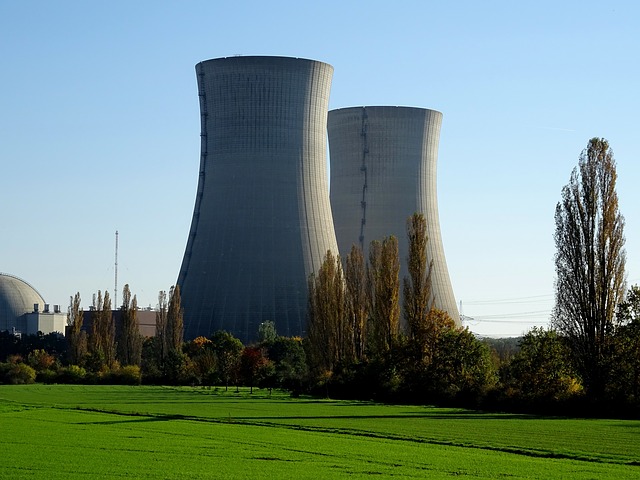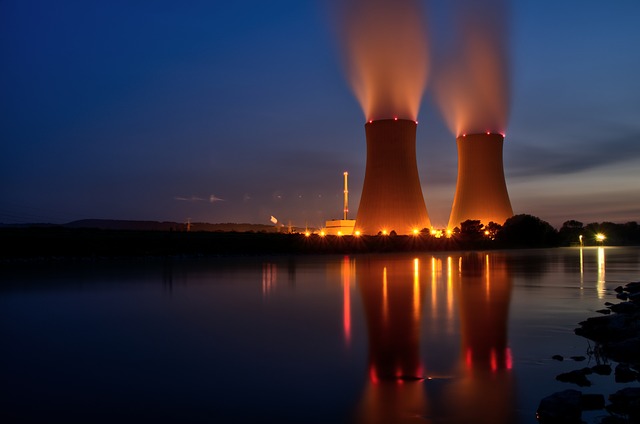What Is Nuclear Energy?

Image via Pixabay
Nuclear energy is produced when uranium atoms are split. This splitting process is referred to as fission. Fission generates heat that produces steam, which is then used by a turbine generator to make electricity.
Because nuclear power plants don’t use fuel, nuclear power proponents tout it as eco-friendly since there are no greenhouse gas emissions to contribute to global warming.
By providing power around the clock, nuclear energy is an essential part of meeting the world’s demand for electricity. It’s also a clean energy resource since there are no carbon emissions associated with its production.
Nuclear power is a global enterprise since all areas of the world are involved in its development. So, is nuclear energy renewable? We’ll get to that shortly.
- Cravens, Gwyneth (Author)
- English (Publication Language)
- 439 Pages - 10/14/2008 (Publication Date) - Vintage (Publisher)
Advantages of Nuclear Energy
Though there have been a few widely reported accidents with nuclear reactors over the years, the fact is that nuclear energy is clean energy safe for the environment if properly managed.
While there may be no threat of a massive disaster associated with them, using fossil fuels to generate electricity is not good for the environment since they produce vast amounts of greenhouse gasses. The following are advantages to nuclear power.

Image via Pixabay
Reliability
Nuclear reactors produce impressive electricity for over 90% of the time they’re in operation. The refueling process has been streamlined over the years, so reactors operate much more efficiently.
Original reactors were designed, built and licensed to work for over 40 years and most nearing that age are in excellent condition and projections are that they could still operate for at least 20 more years.
Energy Production Leads to No Greenhouse Gasses
The operation of a nuclear reactor produces no greenhouse gasses (a key point for proponents when asked, is nuclear power renewable?).
While it’s true peripheral aspects of nuclear power, such as mining, enrichment, and waste management associated with uranium involves emission of greenhouse gasses, the total emissions are substantially lower when compared to sources of power using fossil fuels.
Requires Little Space
While most people have probably seen the giant cooling towers associated with nuclear power plants, the fact is that compared to favorite renewable energy sources they require a much smaller area.
Wind turbines, solar cells, and the space needed to grow biomass all require vast parcels of land. As land becomes scarce with a growing population, this will become a big issue that will need much attention.
Consistent and Competitive Cost
The cost of power from fossil fuels is market driven and can be manipulated by many influences. This volatility in pricing is not associated with nuclear energy because nuclear stations don’t run on fuel.
High Level of Safety
Past disasters at Three Mile Island, Chernobyl, and in Japan have taught the designers of today’s nuclear power plants valuable lessons. One is that they no longer depend on external electricity or water supplies for cooling.
They use gravity-fed water, pressurized water tanks, and natural convection heat exchangers which have become part of a network of passive safety systems. Reactors are also often installed underground adding a safeguard against unauthorized access and natural disasters.
Finally, highly trained staff and armed 24-hour security mean that today’s nuclear stations are safer and better protected than ever before.
Powerful and Efficient
Nuclear energy is more powerful and efficient than other alternative energy sources. Advancements in technology have made it perhaps the most viable alternative energy source available and are why most of the developed world is aggressively investing in nuclear power.
Low Operating Costs
While the initial investment in building a nuclear power plant is substantial, the electricity provided once production begins is inexpensive compared to other energy sources.
Uranium, the raw material needed to produce nuclear energy, is relatively abundant and cheap. Also, operating maintenance costs for a nuclear power station are low. These factors are not likely to transform in the foreseeable future.
Interesting Facts about Nuclear Energy
Before we discuss the “is nuclear energy renewable?” question, let’s look at some interesting facts about nuclear energy. Even though it’s been around since the 1940s, it remains a mystery to many people.
Outside of its wartime applications, occasional news-making demonstrations against its use and a handful of horrific accidents, nuclear energy has had a relatively quiet existence.

Image via Pixabay
- Ferguson, Charles D. (Author)
- English (Publication Language)
- 222 Pages - 05/17/2011 (Publication Date) - Oxford University Press (Publisher)
Is Nuclear Energy Renewable? Arguments For
Those who support nuclear energy’s inclusion as one of the renewable energy sources highlight the low carbon emissions of nuclear energy as its dominant characteristic of integration.
If a renewable energy infrastructure aims to reduce carbon emissions, proponents say there is no reason for not including nuclear energy on any list of renewable energy sources.
Some proponents of the idea consider nuclear energy renewable based on the possibilities they see in the development of thorium as a fuel for nuclear stations. Thorium is a naturally occurring metal with modest radioactive properties.
It’s found in small amounts in rocks and soils and is about three times more abundant than uranium. It’s insoluble, so unlike uranium, it’s not present in the salt waters of the oceans.
Thorium is not directly usable in a thermal neutron reactor. They consider it “fertile” and upon absorbing a neutron will transmute to uranium-233. The technology is not in place to make this conversion but is being worked on, mainly in China, with positive results. If Thorium can be converted to usable fuel, it enhances the argument that nuclear energy is renewable.
Finally, reactors referred to as breeder reactors, which are nuclear reactors capable of generating more fissile material than they consume, can use thorium as fuel. The technology was begun in the U.S., but as more valuable uranium deposits were discovered, interest died down.
There are breeder reactors in use in some countries, and again, China is a leader in attempting to perfect this technology with some support from the U.S., if this technology is put into widespread use, the argument for including nuclear energy on the list of renewable energy sources would be strengthened.
- Frahm, Amelia (Author)
- English (Publication Language)
- 36 Pages - 03/13/2012 (Publication Date) - Nutcracker Publishing Company (Publisher)
Conclusion
With a long history, including advancements made in technology and safety, nuclear energy will be around a long time. The fact that its production process is eco-friendly is exciting to proponents of its expanded use.
The radioactive waste it produces is a big red flag for those who are less enthusiastic about its future. How about an answer to the question “is nuclear energy renewable”?That one may prove to be the most difficult of all to answer. It would seem to come down to the definition of what renewable energy is and the requirements that need to be met to be classified as such.
The International Renewable Energy Agency has taken the position they will not support nuclear energy at all because of its complicated production process, it produces large amounts of radioactive waste and the fact it’s relatively risky.
By them taking that position, nuclear energy proponents need to tackle nuclear waste management before sustainability comes into play.If new technologies are developed, such as breeder reactors and the efficient use of thorium, then the argument to include nuclear energy on the sustainable list is bolstered.
The combination of those advancements would make sustainability a non-issue and could turn the argument on its ear. Whatever happens, nuclear energy will remain a valuable energy resource for the world, mainly as fossil fuel driven energies to begin to be depleted.
Last update on 2024-04-23 at 03:23 / Affiliate links / Images from Amazon Product Advertising API Details



Leave a Reply